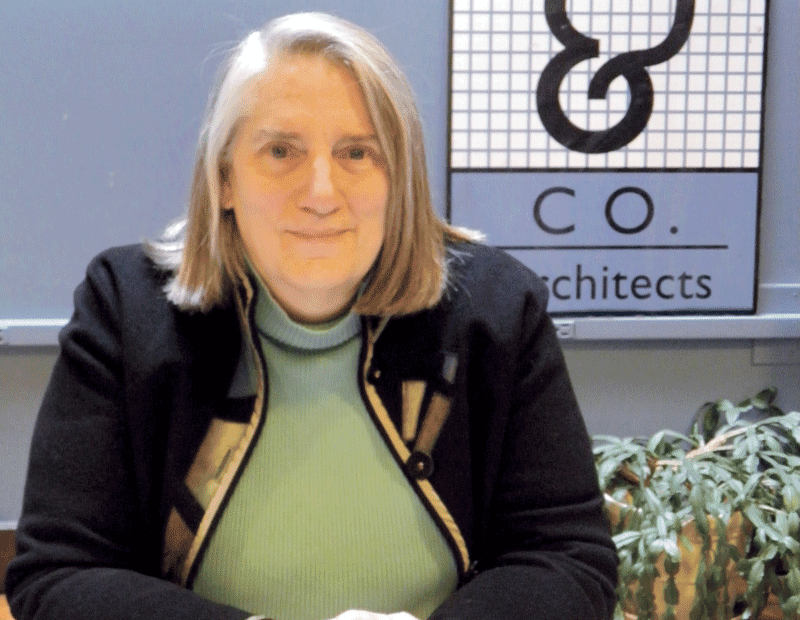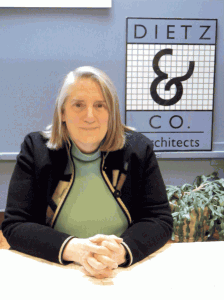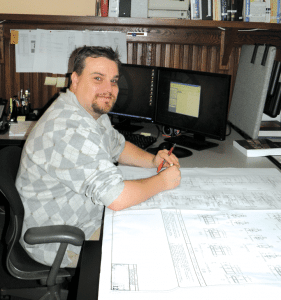
An Eye for Innovation
At Dietz & Co. Architects, Sustainability Is a Way of Life

Kerry Dietz, says the design work her firm does must meet clients’ needs and budgets and also create a sustainable and comfortable environment for the people who will occupy or work in the buildings.
Kerry Dietz was talking about sustainable building design.
And although many people associate the concept with ‘green’ construction, to Dietz, the word ‘sustainable’ encompasses a wide range of considerations.
“Design is critical and happens at many levels, and the word ‘sustainable”’means a lot of different things to our clients,” said the principal of Springfield-based Dietz and Co. Architects Inc.
At Dietz, it includes the comfort and health of those who will live and work in a structure, the aesthetics inside and out, and the costs to maintain a structure during its life cycle, which is especially important to nonprofits that may not have the resources to do maintenance work in the future. “It also includes the materials, the context a building sits in, and the image the client wants to project, because a building can become a brand (more about that later). “It is all critical to us,” she said.
Her company’s tagline is “design that looks good, does good,” and that value has remained key to the way the firm has approached its projects for the past 25 years.
“People know they can count on us to do quality work and do it right,” Dietz told BusinessWest, adding that the entire staff believes their designs should make a difference in the community. “We have never faltered from that initial desire to create architecture that also serves. We are a company that pledges to be a responsible citizen in everything we do.”
Their projects range from affordable housing, which has always been a mainstay of the firm, to education, health care, commercial, institutional, and historic-preservation work. Part of the company’s success is attributed not only to having employees who are experts in their fields, but also to the fact that everyone working on a project is well-versed in its finances.
“We are an open-book company, and my employees know the budgets on our projects, which includes how much money we are making and how many new jobs there will be,” said Dietz, adding that, when there is a profit, everyone shares in it. “People who come here from other firms are surprised at this, but I believe my employees need to know the rules of the game and what the parameters are in terms of hours and months allocated to it.”
Blueprint for Success
Dietz said architectural firms in Western Mass. have to be generalists. “There is not enough work here to be a niche operator unless you are global in scale,” she explained.
However, one of the firm’s challenges is competing with Boston-based companies. “Every time the economy goes south, they come here. And sometimes they bring a level of expertise we don’t have,” she explained. “For example, we haven’t designed 50 schools, and we have never designed a library, so we will never get one. People want to hire someone who has done the job before.”

Michael Erickson, an architectural associate at Dietz & Co. Architects Inc., works on a design for one of their many projects that range from affordable housing to education, health care, commercial, institutional, and historic preservation.
“Architectural firms are altruistic to begin with, but for this firm, serving the community is at the core of our values,” she continued. “We tend to attract employees whose desire is to serve, and we do a lot of work for nonprofits. We understand the pressures they are under in terms of funding.”
Another niche for the company is education, especially colleges and universities, said Dietz, adding that the firm is also well-versed in the challenges, fiscal and otherwise, facing both public and private institutions. “Their decision-making and funding sources and flow are totally different from affordable housing.”
When schools receive grants, the work has to be done right away, and most institutions are dependent on state funding and bonding, so any time a financial crisis hits, it affects their budgets immediately, she went on. “But we like doing the work. It ranges from designing new environmental centers to cafés in science buildings, to work in their libraries.”
Banks are also a specialty. The firm designed Easthampton Savings Bank’s new main office and is renovating some of its branches. “We have also done work for United Bank and have been involved in master plans and studies,” Dietz said.
Staying Afloat
In recent years, the firm’s focus has shifted. It is designing less affordable housing and has broadened its base, in part because the economy has made it difficult for nonprofit developers to get funding.
“The heart of the recession was horrid; it was an equal-opportunity destroyer, and we were lucky to survive it. In 2008 and 2009, we had the worst two years we have ever had. Then in 2010 we had the best year we have ever had in our history,” Dietz said.
She attributes the firm’s success to carefully crafted strategic planning, and said its forecasting tools yielded indications that the recession was imminent. “By October of 2008, it was clear we were headed toward a major disaster. And we knew 2009 would be horrible and we were unlikely to get any new work.”
Although many architectural firms laid off employees or closed their doors, Dietz chose to keep all 19 employees on staff. She cut her own salary and reduced employees’ hours, taking advantage of a graduated program within the state’s unemployment system.
“It allowed us to reduce hours without substantially penalizing our employees, which was important, because we still had projects we were working on,” Dietz said. And although it would have cost less to lay employees off, she knew that, by keeping them, the company was positioned well, as there would be clients who would want to take advantage of declining construction prices.
The company has won a number of awards, and individuals within it have also earned accolades. Dietz said one of the firm’s architects received an e-mail from the Department of Public Health stating that her submission for the Caring Health Center, a recent project in Springfield delayed by the June 1 tornado, “was the best she had ever seen in her history.”
“The ability to make these people happy is a huge selling point for us,” Dietz said, adding that it takes a lot of expertise and work to meet complex and detailed requirements.
She added that much of the housing design they do is dependent on low-income tax credits, and they are also knowledgeable about those requirements due to their 25-year history in that arena.
Attention to Detail
An architectural design contains many elements and can become a “brand,” said Dietz, as she talked about the building the firm created for the YWCA of Western Mass. about 10 years ago.
“The organization almost died about 25 years ago,” said Dietz. “They came to us when they were on their last legs and had sites scattered in a variety of office buildings. They told us they wanted a new facility that looked corporate and would let people know their importance as one of the largest human-service agencies in the area.”
So the firm designed a building for the YWCA that “became a reflection of who they are and their vision for the future. Sustainable meant a lot of things to them, including choosing a high-efficiency heating and air-conditioning system as well as exterior materials that wouldn’t require maintenance,” she said.
Dietz said it’s critical to her company’s mission to think about who will use the buildings they design. Office workers need to have enough light and should not be distracted by noise or each other, for example.
“We really try to integrate our philosophy about sustainable design into everything we do; it’s not new to us, and some of the folks who work with me have been thinking this way for 20 years — sustainability is like religion,” she told BusinessWest, explaining that, although the U.S. Green Building Council developed a system of measurements for green building and Dietz and some of her employees are LEED-certified, there are a variety of measures that can be used to promote sustainability.
“We look at the human cost in terms of materials, rather than just the dollar cost,” she said. For example, although many buildings contain vinyl floor tiles, maintaining them requires expensive chemicals, which are not good for the environment; the people who work with them or the employees who will inhale the fumes of the cleaning solutions.
Unchanging Goals
“Since we opened our doors in 1985, we’ve worked to provide an environment that’s both challenging and nurturing,” Dietz said, adding that this begins within the company and extends to the nuances of every project.
“We never lose sight of our ultimate goal: to interpret our clients’ personal vision and create spaces that look great, feel great, and serve the needs of the people who will use these spaces,” she added.
And they do so in a way that creates comfort — and sustainability — now and for generations to come.




